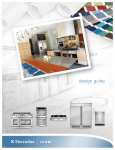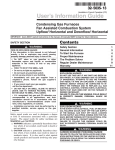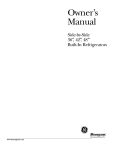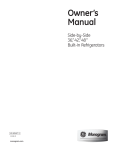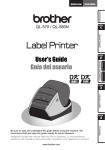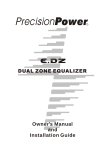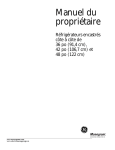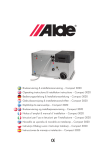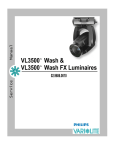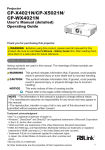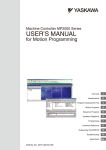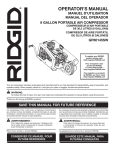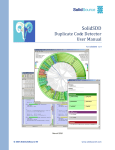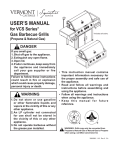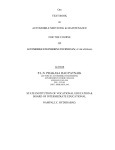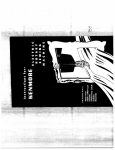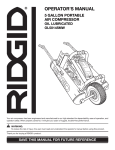Download Service Manual. 42 inch BI pmd.pmd
Transcript
Built-in Side by Side Refrigerator May 2005 1 5995432258 SAFE SERVICING PRACTICES - ALL APPLIANCES To avoid personal injury and/or property damage, it is important that Safe Servicing Practices be observed. The following are some limited examples of safe practices: 1. DO NOT attempt a product repair if you have any doubts as to your ability to complete it in a safe and satisfactory manner. 2. Before servicing or moving an appliance: • Remove the power cord from the electrical outlet, trip the circuit breaker to the OFF position, or remove the fuse. • Turn off the gas supply. • Turn off the water supply. 3. Never interfere with the proper operation of any safety device. 4. USE ONLY REPLACEMENT PARTS CATALOGED FOR THIS APPLIANCE. SUBSTITUTIONS MAY DEFEAT COMPLIANCE WITH SAFETY STANDARDS SET FOR HOME APPLIANCES. 5. GROUNDING: The standard color coding for safety ground wires is GREEN, or GREEN with YELLOW STRIPES. Ground leads are not to be used as current carrying conductors. It is EXTREMELY important that the service technician reestablish all safety grounds prior to completion of service. Failure to do so will create a hazard. 6. Prior to returning the product to service, ensure that: • All electrical connections are correct and secure • All electrical leads are properly dressed and secured away from sharp edges, high-temperature components, and moving parts • All non-insulated electrical terminals, connectors, heaters, etc. are adequately spaced away from all metal parts and panels • All safety grounds (both internal and external) are correctly and securely connected • All panels are properly and securely reassembled ATTENTION!!! This service manual is intended for use by persons having electrical and mechnical training and a level of knowledge of these subjects generally considered acceptable in the appliance repair trade. Electrolux Home Products cannot be responsible, nor assume any liability, for injury or damage of any kind arising from the use of this manual. © 2001 White Consolidated Industries 5995432258 2 Table of Contents 3-Way Valve .................................................................................................................................40 Auger Motor .................................................................................................................................32 Casters and Leveling ....................................................................................................................26 Components ................................................................................................................................. 23 Component Locator Views ...........................................................................................................12 Component Resistance Values ...................................................................................................... 8 Compressor .................................................................................................................................. 39 - 61to 65 Control Features ............................................................................................................................10 Cube Motor and Cube Reed Switch ..............................................................................................32 Defrost Cycles ...............................................................................................................................43 Diagnostic Mode ...........................................................................................................................54 Dispenser Control Panel ................................................................................................................34 Dispenser Heater ...........................................................................................................................37 Dispenser Switch ...........................................................................................................................37 Doors ............................................................................................................................................ 23 Door Closer Assembly ...................................................................................................................25 Door Switches ............................................................................................................................... 41 Door Water Line Replacement .......................................................................................................38 Drain Pan ...................................................................................................................................... 26 Drier .............................................................................................................................................. 40 Duct Door Assembly ......................................................................................................................36 Evacuation and Charging Procedure ............................................................................................. 16 Fans .............................................................................................................................................. 44 Freezer Evaporator Assembly ....................................................................................................... 46 Freezer Evaporator Components .................................................................................................. 49 Freezer Heater Testing .................................................................................................................. 46 Fresh Food Evaporator Assembly ................................................................................................. 50 Fresh Food Evaporator Components ............................................................................................ 52 Fresh Food Heater Testing ............................................................................................................ 50 Heat Exchanger ............................................................................................................................. 39 Icemaker Controls ..........................................................................................................................11 Icemaker Fill Tube and Heater .......................................................................................................31 Ice Bin and Icemaker .....................................................................................................................31 Ice Dispenser ................................................................................................................................ 35 Installation Example 42" Model ......................................................................................................5 Interior Airfl ow .............................................................................................................................17 Interior Lights ................................................................................................................................42 Introduction ................................................................................................................................... 4 Machine Compartment Access Door .............................................................................................23 Main Switch ..................................................................................................................................34 Mufflers .........................................................................................................................................39 Nomenclature ............................................................................................................................... 9 Power Control Board (PCB) ..........................................................................................................27 Refrigerant Flow ............................................................................................................................14 Refrigeration Components .............................................................................................................13 Refrigeration System .....................................................................................................................13 Replacing the Freezer or Fresh Food Evaporator ........................................................................ 52 Schematics ................................................................................................................................... 58 Service Diagnostics ...................................................................................................................... 54 to 65 Technical Data ............................................................................................................................... 8 Terminal Block Panel .....................................................................................................................29 Thermistors ................................................................................................................................... 42 Troubleshooting Notes .................................................................................................................. 57 Water Valve and Water Tank ......................................................................................................... 35 IntroductionINTRODUCTION 3 5995432258 INTRODUCTION The new Profi le Built-In Side by Side refrigerator has the following features: • Separate freezer and fresh food evaporators are recessed into the machine compartment for increased effi ciency and interior space savings. • 3-Way valve directs refrigerant fl ow where needed. • High-and low-side sealed system muffl ers quiet the operation. • Inverter is built into the power control board (PCB). • Combined dispenser and temperature control board provides customer control and test mode operations. • Dispenser cube motor and cam replaces solenoid-operated cube mechanism. • Room ambient thermistor aids power control board (PCB) operation. • Component electrical testing is performed at the machine compartment-mounted terminal block. • Rear leveling mechanism is front-adjustable. Installation Example 42" Mo 5995432258 4 INSTALLATION EXAMPLE 42” MODEL THE INSTALLATION SPACE DIMENSIONS AND CLEARANCES *Shipping height The front height may be adjusted from 83-1/2" to 84-1/2" by adjusting front and rear leveling legs a maximum of 1". 7” * The finished cutout width must be: 41-1/2” for 42” models Water and Electrical Locations The opening must be prepared with the electrical and water supply located as shown. The cutout depth must be 24" The refrigerator will project forward, slightly beyond adjacent cabinets, depending on your installation. Additional Specifications • A 120 volt, 60Hz, 15 or 20 amp power supply is required. An individual properly grounded branch circuit or circuit breaker is recommended. Install a properly grounded 3-prong electrical receptacle recessed into the back wall. Electrical must be located on rear wall as shown. Note: GFI (ground fault interrupter) is not recommended. • Water line can enter the opening through the floor or rear wall. The water line installed should be 1/4" O.D. copper tubing between the cold water line and water connection location. The line should be long enough to extend to the front of the refrigerator. Installation of an easily accessible shutoff valve in the water line is required. Product Clearances These refrigerators are equipped with a 2 position door stop. The factory set 130° door swing can be adjusted to 90° if clearance to adjacent cabinets or walls is restricted May Change with our handle Allow minimum clearances for Freezer door (Dimension A) and Fresh Food door (Dimension B) for a full 130° door swing and to allow for drawer removal. Four inch (4") minimum clearance is required when door swing is adjusted to 90°. If the 90° door stop position is used, drawer access is maintained, but drawer removal is restricted. Wood Panel 70 LB food door 30 LB freezer door 5 5995432258 5995432258 6 DISCONNECT POWER CORD BEFORE SERVICING IMPORTANT - RECONNECT ALL GROUNDING DEVICES 7 5995432258 TECHNICAL DATA IMPORTANT SAFETY NOTICE All parts of this appliance capable of conducting electrical current are grounded. If grounding wires, screws, straps, clips, nuts or washers used to complete a path to ground are removed for service, they must be returned to their original position and properly fastened. This information is intended for use by individuals possessing adequate backgrounds of electrical, electronic and mechanical experience. Any attempt to repair a major appliance may result in personal injury and property damage. The manufacturer or seller cannot be responsible for the interpretation of this information, nor can it assume any liability in connection with its use. CAUTION To avoid personal injury when servicing the condensing unit, stand on a ladder which will give enough support to allow removal of the top panel and safely allow access to service the unit. NO LOAD PERFORMANCE Control Position 37-0°F and Ambient Temperature of: 70°F 90°F Fresh Food °F 37-42 36-43 Frozen Food °F (-2)-2 (-2)-5 Percent Running Time, %..........35-45 65-75 REFRIGERATION DIAGNOSIS ELECTRICAL SPECIFICATIONS Max Defrost Control w/No Door Openings........................16 hrs Evap Defrost Thermistor........68°F (FZ)..63°F (FF) Electrical Rating: 115V AC 60 HZ.............5.4 amp Maximum Current Leakage......................0.75 mA Maximum Ground Path Resistance...............0.1 W Energy Consumption Model 42........50.5 KWh/mo Energy Consumption Model 48......53.75 KWh/mo REFRIGERATION DIAGNOSIS To access the low pressure side of the system, install a line tap valve on the process tube extending from the compressor case. COMPOENENT RESISTANCE VALUES FF fan motor ……………………..............1600 &! ± 20% FZ fan motor ………………………….......1600 &! ± 20% Condenser fan motor ………………........1600 &! ± 20% Auger motor ………………………..............3.7 &! ± 15% Cube motor …………………………….....2091 &! ± 10% Cover motor ……………………………....2091 &! ± 10% Defrost heater FZ ……..................................44 &! ± 7% Drain heater FZ ..........................................377 &! ± 7% Sub-heater FZ ………...............................1322 &! ± 7% Defrost heater FF .......................................120 &! ± 7% Drain heater FF …......................................440 &! ± 7% Fill-tube heater .……….............................2645 &! ± 7% Dispenser heater (Recess)………………..1889 &! ± 7% Compressor (between the different phase) …………….....................11. 7 &! ± 7% / 1 phase 3- way valve …………………………..40 ± 4 &!/ 1 phase Water valve (Ice maker) …………...............180 &! ± 7% Water valve (Dispenser) ..………................325 &! ± 7% REFRIGERATION SYSTEM Refrigerant Charge (R134a)......................8.11 ounces Compressor......................................738-1270 BTU/hr Minimum Compressor Capacity Vacuum..........................................................26 inches Minimum Equalized Pressure @70°F.............................................................66 PSIG @90°F.............................................................74 PSIG To change the Technical Data Nomenclature Icemaker Controls 5995432258 8 MODEL AND SERIAL NUMBER INFORMATION E42BS85EPS THE PS IS FOR STAINLESS STEEL E42BS75ETT THE TT IS FOR MODEL WITH TRIM ON DOORS Serial Plate Location Serial Number The Serial plate is located at the top of the fresh food section on the right-side wall. It contains the model and serial numbers and specifi es the minimum installation clearances, electrical voltage, frequency, maximum amperage rating, and refrigerant charge. The first letter tells us where the product was made, the second letter tells us what type product it is. The first number is the year the product was made. The next two numbers are the week the product was made. Example BA51400000, B - Is the Anderson refrigerator factory. A - Is a refrigerator 5 - Is 2005 14 - Is week 14 The rest of the numbers are the sequence number for week 14 of 2005. Mini-Manual The mini-manual is located behind the grille panel at the top of the refrigerator. When service is completed, return the mini-manual to its original location for future use. 9 5995432258 Control Features The temperature controls are preset in the factory at 37°F for the refrigerator compartment and 0°F for the freezer compartment. Allow 24 hours for the temperature to stabilize to the preset recommended settings. The temperature controls can display both the SET temperature as well as the actual temperature in the refrigerator and freezer. The actual temperature may vary slightly from the SET temperature based on usage and operating environment. NOTE: The refrigerator is shipped with protective film covering the temperature controls. If this film was not removed during installation, remove it now. Once the desired temperature has been set, the temperature display will clear after 10 seconds. To display the temperature, the DISPLAY TEMP button may be tapped. Several adjustments may be required. Each time you adjust controls, allow 24 hours for the refrigerator to reach the temperature you have set. Icemaker Controls 5995432258 10 Quick Ice When you need ice in a hurry, press this button to speed up ice production. This will increase ice production for the following 48 hours or until you press the button again. Dispenser Light This button turns the night light on the dispenser on and off. The light also comes on when the dispenser pad is pressed. If this light burns out, it should be replaced with a 6 watt 12V maximum bulb. To Use the Dispenser Select CUBED , CRUSHED or WATER . Press the glass gently against the middle of the dispenser pad. The spill shelf is not self-draining.To reduce water spotting, the shelf and its grille should be cleaned regularly. If no water is dispensed when the refrigerator is first installed, there may be air in the water line system. Press the dispenser arm for at least two minutes to remove trapped air from the water line and to fill the water system. To flush out impurities in the water line, throw away the first six glassfuls of water. CAUTION: Never put fingers or any other objects into the ice crusher discharge opening. Door Alarm To turn the Door Alarm on, press the DOOR ALARM button once. The ACTIVE light will come on. To turn it off, press it again. When the DOOR ALARM is active, the ACTIVE light will flash if you open the door and beep if you keep the door open for more than 2 minutes. The light goes out and the beeping stops when you close the door. Spill Shelf Locking the Dispenser Press the LOCK/LIGHT button for 3 seconds to lock the dispenser and control panel. To unlock, press and hold the button again for 3 seconds. Note: When QUICK ICE is selected, the freezer temperature operates at -9°F for 48 hours or until QUICK ICE is pressed again. There is no change of temperature on the display panel. In the event of a power loss, if the freezer temperature is above 40°F, Quick Ice will not restart. Below 40°F, the refrigerator will return to the Quick Ice mode. Display after power failure: After a power failure, the display will reset based on freezer temperature. If the freezer temperature is below 40°F, the display will retain the settings prior to power loss. The chart at the right describes the possible settings. 11 5995432258 Component Locator Views Component Locator Views 5995432258 12 Refrigeration System Refrigeration Components 13 5995432258 or the fresh food and freezer evaporators, refrigerant fl ows through the appropriate capillary tube and into the evaporator. As the high pressure liquid passes through the capillary and enters the low pressure evaporator, it quickly expands and evaporates. During evaporation, the refrigerant absorbs heat, becoming cold. At the outlet of the freezer evaporator, an accumulator captures any remaining liquid, allowing only low pressure vapor to return to the compressor through the suction line. Refrigerant Flow The compressor compresses R134a refrigerant, raising its pressure and temperature. Refrigerant vapor is pumped out the compressor discharge, down through the drain pan loop, up through the condenser coil, around the condenser loop, through the drier, and into the 3-way valve. By the time the refrigerant has reached the 3-way valve, it has completely condensed into a liquid. Depending upon whether the main control board opens the 3-way valve to the freezer evaporator 5995432258 14 Note: The refrigerator will operate with the 3-way valve set for freezer only or set for fresh food and freezer. There is no 3-way valve setting for fresh food only. If the fresh food thermistor is not satisfi ed, but the freezer thermistor is satisfi ed, the refrigerator will still operate with the 3-way valve set in the fresh food and freezer mode. 15 5995432258 Evacuation and Charging Procedure 2. Start vacuum pump. 3. Open hand shut-off valve and slowly open both manifold valves, turning counterclockwise, for two full rotations. Equipment Needed for Evacuation & Recharging: • Heated charging cylinder • Standard 3-port manifold gauge set: 4 charging hoses Tee fitting with valve core stem removed (Robinair No. 40396) Hand shut-off valve (Robinair No.40380) • Two stage vacuum pump • Process tube adapter kit (Robinair No. 12458) • Tubing cutter • Pinch-off tool capable of making leak proof seal • Complete brazing torch set • Small 3-corner file • Grit cloth or Scotch-Brite • 45% silver solder and flux CAUTION: If high vacuum equipment is used, just crack both manifold valves for a few minutes and then open slowly for the two full turns counterclockwise. This will prevent the compressor oil from foaming and being drawn into the vacuum pump. Installing Evacuation and Recharging Equipment 1. Disconnect refrigerator from electrical supply. 2. If compressor was replaced, install correct sized process tube adaptor on process tube. If compressor was not replaced, cut process tube with tubing cutter leaving as much tube as possible and install correct size process tube adaptor. 3. Install correct sized process tube adaptor on high-side process tube. 4. Attach refrigeration service gauge manifold to system in following order: • Low-side (compound gauge) hose to suction side process tube adaptor. • High-side (pressure gauge) hose to highside process tube adaptor. • Center port manifold hose before hand shut-off valve to charging cylinder. • Center port manifold hose after hand shut-off valve to vacuum pump. Evacuating System WARNING: R-134A SYSTEMS ARE PARTICULARLY SUSCEPTIBLE TO MOISTURE CONTAMINATION WHICH CAN ONLY BE PREVENTED BY EVACUATING THE SYSTEM FOR A MINIMUM OF 30 MINUTES TO ATTAIN A MINIMUM 29.9 INCH (500 MICRON OR LOWER) VACUUM. To achieve the required levels of evacuation, a properly maintained two stage vacuum pump in good condition is required. It is absolutely essential to maintain your vacuum pump according to the manufacturer’s instructions including required oil changes at the recommended intervals. Vacuum pump oil should always be changed after evacuating a contaminated system. Vacuum pump performance should be checked periodically with a micron gauge. 1. Make certain that charging cylinder valve, hand shut-off valve, and manifold gauge valves are closed. 5995432258 16 4. Operate the vacuum pump for a minimum of 30 minutes to a minimum of 29.9” (500 micron) vacuum. 5. Close hand shut-off valve to vacuum pump. Watch compound gauge for several minutes. If reading rises, there is a leak in the system, go to step 6. If no leak is indicated, stop vacuum pump. System is now ready for charging. 6. If a leak is indicated, stop vacuum pump and introduce a small charge of refrigerant into system by cracking valve on bottom of charging cylinder until system is pressurized to 40 or 50 l bs psig. 7. Leak test low-side. Close compound gauge. Run compressor for a few minutes and leak test high-side. When leak is found, recapture refrig erant using EPA approved recovery system Repair and go back to step 1. Charging The System CAUTION: Check the serial plate for the correct refrigerant type. It is extremely important to verify the type of refrigerant in the system before starting any sealed system repairs. CAUTION: After charging the system with liquid be certain to wait at least 5 minutes before starting the compressor to give the refrigerant a chance to disperse throughout the system. Otherwise the compressor could be damaged by attempting to pump excessive quantities of liquid. Preparing The Charging Cylinder: 1. Make certain that hand shut-off valve to vacuum pump is closed. 2. Close high-side manifold gauge valve. 3. Set charging cylinder scale to pressure indicated on cylinder pressure gauge. 4. Observe refrigerant level in sight glass. Subtract amount to be charged into system and note shut off point. 5. Open charging cylinder valve slowly and allow proper charge to enter system. 6. As soon as refrigerant in sight glass has gone down to predetermined level, close charging cylinder valve. 11.Close both of the manifold gauge valves. If the high-side gauge reading rises, the pinch-off must be corrected before proceeding. 12.Remove the high-side process tube adaptor and solder the process tube closed. 13.Clamp the low-side process tube with the pinchoff tool while the unit is running. Remove the low-side process tube adaptor and solder the process tube closed. 14.Check the process tubes for refrigerant leaks. WARNING: DISCONNECT THE CHARGING CYLINDER HEATER AT THIS TIME TO PREVENT THE CYLINDER PRESSURE FROM EXCEEDING ITS MAXIMUM LIMITS. 7. Allow system to sit for five minutes. 8. Turn on refrigerator compressor. Run compres sor for a few minutes and monitor system pressures. 9. When satisfied that the unit is operating cor rectly, clamp the high-side process tube with the pinch-off tool while the unit is still running. 10.Slowly open the high-side manifold gauge valve to allow the compressor to remove any refriger ant trapped in the high-side hose and the process fitting. Final leak test 1. With the refrigerator turned OFF leak test all low-side system components. 2. Turn the unit ON and run until the condenser is warm. Leak test the high-side system components. COMPOUND GAUGE TEE FITTING EVAPORATOR PRESSURE GAUGE GAGE MANIFOLD HAND SHUTOFF VALVE HOT TUBE HEATED CHARGING CYLINDER FILTER DRIER COMPRESSOR CONDENSER PROCESS TUBE ADAPTERS Figure E2 2 STAGE VACUUM PUMP 17 5995432258 R-134a service information NOTICE: Instructions given here are furnished as a guide. Persons attempting to use these instructions to make repairs to the sealed refrigeration system should have a working knowledge of refrigeration and previous training on sealed system repair. Verify refrigerant type in the system and are available in several different variants. Ester oils have a pleasant aroma reminiscent of fruit. CAUTION: R-134a and R-12 are completely incompatible. Before starting any sealed system repair, it is extremely important to check serial plate of product to verify the type of refrigerant in the system. Dedicated Equipment R-134a must not be mixed with other types of refrigerants. R-134a must be recovered in dedicated and properly identified recovery bags and tanks. It will be necessary to check with the manufacturer of your recovery equipment to determine R-134a compatibility. Some recovery equipment manufacturers have changeover instructions for switching between refrigerant types. Protect yourself and your equipment by following all manufacturer guidelines. Also, ensure that your refrigeration hoses are specified for use with R-134a refrigerant. Research has shown that compounds in standard refrigeration hoses may enter sealed systems and ultimately restrict the cap tube in an R-134a system. R-134a refrigeration systems The sealed refrigeration system will consist of the same basic components being utilized in the R-12 systems. There is a 10% to 15% discharge pressure increase using R-134a, with a 5% to 10% decrease in suction pressure when compared to the same product with an R12 system operating at 90°F (32°C) ambient temperature conditions. Lower suction pressures result from the lower density of R-134a refrigerant which effects refrigerant flow rate. R-134a systems commonly operate in a 1”2” vacuum on the suction side. One of the most important requirements made on a refrigerant system is that the oil mix with the refrigerant. Since mineral oil and ordinary synthetic oil DO NOT mix with R-134a, Ester oil is used for lubrication. Ester oil dissolves in R-134a. Ester oil is broken down by chlorine and cannot be used with R-12 (R-12 contains chlorine) or any other compound containing chlorine. Therefore, R-134a refrigeration systems have virtually no tolerance for chlorine molecules from CFC refrigerants (R-134a is an HFC and contains no chlorine). CAUTION: During R-134a service, it is extremely important to avoid using equipment that may contain residual amounts of mineral oil, CFC’s or HCFC’s which could enter and contaminate the sealed system. For example, hoses that were used for a refrigeration system operating on R-12 may contain small quantities of mineral oil which can block the capillary tube in a system operating on R-134a. As little as one milligram may be sufficient to cause a blockage. In addition, sealed system components that have been used with CFC systems must not be used with R-134a systems. These components may contain residual amounts of refrigerant and oil which could damage an R-134a system. Products using R-134a refrigerant will generally have a longer capillary tube to maintain a similar flow rate and some models will have a larger condenser to reduce the discharge pressures and lower start-up sound transmission. At the earliest stage of development work on R134a, tests were carried out on a different type of synthetic oil known as Poly-Alkaline Glycol (PAG). This oil is also used in certain air conditioning systems for cars. PAG and Ester oil DO NOT mix with one another. Service equipment used for R-134a / Ester oil must not come into contact with PAG. Miscibility of r-134a and ester oil A special synthetic oil known as Ester oil is used as a lubricant in refrigeration systems operating on R-134a. Ester oils are produced from alcohols and fatty acids 5995432258 Ester oils generally include various types of additives for improving certain properties such as viscosity, temperature sensitivity, etc. These additives are often aggressive, and skin contact with Ester oils should therefore be avoided. 18 Water in the refrigeration system Even in very small quantities, water in any refrigeration system can cause the following problems: • Ice plugs in capillary tubes. • Copper plating in compressor. • Reactions with organic materials in systems. • Corrosion of metals. 2-Stage Vacuum Pump R-134a and Ester oil will aggravate the problem of water in the refrigeration system. Ester oil may react with water vapor and is hydroscopic (it will absorb water if it comes in contact with humid air). Water is also more soluble in R-134a than R-12. Figure E3 To minimize the water content whenever service work is performed, the refrigeration system should always be thoroughly evacuated through process tube adaptors on both the high and low sides of the system. Evacuation must be for a minimum of 30 minutes to at least a 29.9 inch (500 micron) vacuum. Vacuum pump maintenance It is absolutely essential to maintain your vacuum pump according to the manufacturer’s instructions including required oil changes at the recommended intervals. Vacuum pump oil should always be changed after evacuating a contaminated system. Vacuum pump performance should be checked periodically with a micron gauge. VACUUM CHART Vacuum Inches Hg. Microns Boiling Point of Water °F 28.940 25000 77.9 29.530 10000 52.0 29.832 4600 32.0 29.882 1000 1.0 29.901 500 -11.2 29.915 150 -32.8 29.917 100 -38.2 29.919 50 -49.0 Vacuum pump suppliers may or may not recommend changing the vacuum pump oil to the same type that’s in the system being evacuated. Some manufacturers may recommend a vacuum pump that’s dedicated to R-134a systems. Robinair has stated that their current and discontinued vacuum pump models, using mineral oil currently specified for use in their vacuum pumps, can be used to evacuate R-134a/Ester oil systems. Robinair also states that it is acceptable to alternate between evacuating R-12/mineral oil and R-134a/Ester oil systems without adversely effecting the vacuum pump’s performance. For other brands of vacuum pumps, check with the manufacturer for restrictions and guidelines when using with R-134a. To achieve the required 29.9 inch (500 micron) vacuum, a properly maintained two-stage vacuum pump in good condition is required. A two stage pump can reach a deeper vacuum than a single stage because the exhaust from the first pumping stage is discharged into the second pumping stage. This means the second stage begins pumping at a lower pressure so a lower ultimate vacuum can be achieved (See 2-Stage Vacuum Pump, Figure E3). 19 CAUTION: If you use a vacuum pump with mineral oil to evacuate an R-134a system, it is ABSOLUTELY ESSENTIAL to have a shutoff valve between pump and your manifold gauge set as shown in Figure E4. The hand valve must be closed during all times when vacuum pump is not operating. This will prevent migration of mineral oil vapor into R134a/Ester oil system. If vacuum pump should stop during evacuation for any reason, the hand pump shut-off valve must be closed immediately. 5995432258 COMPOUND GAUGE TEE FITTING EVAPORATOR PRESSURE GAUGE GAGE MANIFOLD HAND SHUTOFF VALVE HOT TUBE HEATED CHARGING CYLINDER FILTER DRIER COMPRESSOR Figure E4 CONDENSER PROCESS TUBE ADAPTERS Evacuating and Recharging Connections 2 STAGE VACUUM PUMP Refrigerant leaks A system with R-134a and Ester oil will become saturated with moisture much faster than a system with R-12 and mineral oil. The compressor in an R-134a system will have to be replaced if the product has had a low side leak. R-134a refrigerant molecules are smaller than R-12 molecules. This means that R-134a will pass more minor leaks and the rate of flow will be greater than for R-12. Therefore, it is now more important than ever to follow good brazing practices. Use a good grade of silver solder. 45% silver solder is recommended. leak detection R-134a system leaks can be pinpointed by means of an electronic leak detector or by bubble solution. Electronic leak detectors for R-134a service are currently available from several manufacturers. The least expensive models are non-selective detectors that will detect any type of emission or vapor present, regardless of its chemical composition. Some non-selective detectors designed for use with R-12 may have a much lower sensitivity when used with R-134a. However, newly designed detectors with good R-134a sensitivity are now available. Be sure to consult with the manufacturer before selecting or using a non-selective detector with R-134a. Halogen-specific detectors use a specialized sensor that allows detection of compounds containing chlorine, fluorine, bromine, and iodine without being activiated by other species. The major advantage of this type of detector is a reduction in the number of “nuisance alarms”. Halogen-specific detectors are generally more expensive 5995432258 20 than non-selective detectors but feature higher sensitivity.R-134a properties R-134a properties The properties of R-134a are very similar to those of R12. The principal data for the two refrigerants are shown in the chart below. REFRIGERANT S R-12 R-134a NAME Dichlorodifluoromethane 1,1,1,2--Tetrafluoromethane Formula CCI2F2 CH2F-CF3 Molecular Weight (g/mol) 120.93 102.3 Ozone Depletion Potential (ODP) 1 0 Global Warming Potential (GWP) 3.1 0.3 Boiling Point °F -21.6 -15.7 Vapor Pressure (77°F) 80 psig 82 psig Flammability None None Solubility of Water in Refrigerant (wt% @ 77°F) 0.009 0.11 4. Open the ball valve. Recover the purge/ sweep charge using the recovery pump and the refrigerator compressor until a 20-in. vacuum is attained. Close the ball valve and remove the recovery hose. Evacuation and Charging Procedure using Sweep Charge. WARNING: 5. Charge the system with the exact amount of R 134a refrigerant specifi ed. • Before cutting or using a torch on refrigerant tubes, recover the refrigerant from the system using approved recovery equipment. • Never charge new refrigerant through the purge valve. This valve is always located on the high pressure side of the system. 6. Disconnect the power cord to the refrigerator. This allows the pressure to equalize. After 3 to 5 minutes, the low-side pressure will be positive and then the hose-to-charging port can be disconnected. • Never apply heat from any source to a container of refrigerant. Such action will cause excessive pressure in the container. 7. Using an electronic leak detector, check all brazed joints and both schrader ports. Reinstall caps to schrader ports. • Always wear goggles when working with refrigerants and nitrogen holding a charge in some replacement parts. Contact with these gases may cause injury. 1. Attach the hose from the R-134a charging cylinder to the process tube port on the compressor. 2. Evacuate the system to a minimum 20-in. vacuum using the refrigerator compressor and recovery pump, which is attached to the new drier assembly. 3. Turn off the recovery pump. Close the ball valve on the hose connected to the high-side port connection. Add 3 ounces of R-134a refrigerant to the system. Let the refrigerator operate and circulate the refrigerant for 5 minutes. 21 5995432258 Interior Airflow Note: The fans are extremely quiet. Check for airfl ow at the icemaker air duct in the freezer and the top tower vent in the fresh food section. Fans turn off when the doors are opened (DC door switches control operation) and delay 10 seconds before restarting when the doors are closed again. The freezer door switch controls only the freezer fan. The fresh food door switch controls both the fresh food and freezer fan operation. Components 5995432258 22 Components Machine Compartment Access Door The machine compartment access door is held in place by 2 hinges and 2 gas shocks. To remove the machine compartment access door: 1. Remove the grille panel. 2. Remove the gas shocks from the cabinet: a. Insert a small screwdriver under the retainer clip. b. Pull the retainer inward to dislodge the gas shock from the pivot ball. 3. Remove the 2 screws from both hinges, then remove the machine compartment access door. does not allow the door to swing open fully to 130°, the stop can be adjusted to a 90° door swing. The pin is factory installed in the 130° location. To change the stop location, use a fl athead screwdriver to move the stop pin. Doors The doors are of one-piece construction with foamed-in insulation. The inner and outer door panels cannot be separated and must be replaced as an assembly. Note: On trimmed models, the maximum weight for the fresh food door panel is 70 pounds. The maximum weight for the freezer door panel is 30 pounds. Door Alignment The freezer door is nonadjustable. The fresh food door has an adjustment screw at the bottom hinge. Use a 7/32in. socket or open-end wrench to turn the adjusting screw clockwise to raise the door, or counterclockwise to lower the door. A lockin screw using a Phillips head screw is used to hold the adjusting screw in place. You must loosen this screw to adjust the door. Note: Raising the fresh food door too high will cause the upper hinge to bind on the machine compartment access door. Door Removal WARNING: Use the appropriate safety equipment and lifting techniques. Two persons may be required for door removal. Caution: Use wood or a heavy plastic sheet to protect the floor where the door will be placed. 1. Remove the 8-mm mounting screw from the hinge arm link using a 5/16-in. or 8-mm socket. 2. If removing the freezer door, shut off the water supply and disconnect the water line and electrical connectors. if removing the refrigerator door, disconnect the static ground wire from the grounding screw. Door Stop The refrigerator has a 2-position door stop. When space 23 5995432258 2. If removing the freezer door, shut off the water supply and disconnect the water line and electrical connectors. If removing the refrigerator door, disconnect the ststic ground wire from the grounding screw. 3. Remove the upper hinge. 4. Lift the door up and out. Door Closer Assembly Each door is equipped with a door closer assembly that provides a smooth closing action and prevents the door from being slammed shut. The assembly is connected to the bottom hinge. When the door is open to a 90° position, it will automatically close. Beyond this position, the door will stay open. Door Gaskets The fresh food and freezer doors have magnetic gaskets that create a positive seal to the front of the steel cabinet. The cabinet has magnets around the perimeter and center mullion under the front edge. To remove the door closer assembly: 1. Remove the toe plate. 2. Remove the 8-mm mounting screw. 3. Insert a small screwdriver into the retaining clip at the bottom of the shock absorber and lift up (see photo). 4. Using a large screwdriver, lever the shock absorber off the pivot ball as shown. The magnetic door gaskets are secured to the doors by a barbed edge that locks into a retainer channel. To remove and replace the door gasket: 1. Starting at any corner, pull the old gasket out of the retaining channel. 2. Soak the new gasket in warm water to make it pliable. 3. Push the barbed edge of the gasket into the retainer channel. 5995432258 5. Remove the door closer assembly by pulling it forward. Make certain to retain the white nylon shock absorber support. 24 Side Magnet Replacement To install the door closer: 1. To make installation of the shock absorber easier, secure the white nylon support to the cylinder body with electrical tape. 1. Remove side case trim. Trim 2. The hot gas loop will be visible between the front baker strip and cabinet. Carefully move the hot gas loop tubing out of the space between barker strip and cabi net. The case magnet is behind the hot gas loop tubing. 2. Ensure the opening on the white nylon support faces towards the inside of the cabinet. NOTE: Tape in place when installing in the field, this will prevent support from falling off before closer is in place. Hot Gas loop 3. Make sure the door closer assembly support is fully seated in the bracket to ensure alignment of ball and socket. 3. With the hot gas loop out of the channel, the cabinet magnet can be removed from the channel, using a flat screw driver or putty knife to assist. Magnet Hot Gas loop 4. Rotate magnet and reinsert into breaker/cabinet channel. 5. Reinsert hot gas loop tubing in breaker/cabinet channel 6. Tape may be necessary to hold hot gas loop tubing in channel while trim is installed. 7. Re-install side trim. 25 5995432258 Casters and Leveling Leveling is provided by 2 adjustable rear levelers and 2 front leveling legs. The unit has 4 fi xed casters that are used to position the refrigerator. When adjusting the rear levelers, turn the 7/16-in. hex nut, located above the front casters, clockwise to lower, or counterclockwise to raise. When adjusting the front legs, use an open-end wrench and turn the front legs clockwise to lower, or counterclockwise to raise. Note: The rear levelers and the 4 casters are each attached to the refrigerator with four 10-mm screws. To access the screws, raise or tilt the refrigerator. The defrost water in the pan is evaporated by use of a submersible serpentine coil, which is part of the sealed system. The tubing is copper coated with black paint. Warning: Use the appropriate safety equipment and lifting techniques. Two persons may be required. Drain Pan The drain pan can be removed for cleaning purposes. Drain pan removal: 1. Remove the toe plate. 2. To remove the drain pan, grasp the center of the drain pan and pull outward. 3. To install the drain pan, slide it back into position so the rear and front mounting tabs engage. 4. Firmly push the drain pan into position. 5995432258 26 Power Control Board (PCB) The PCB housing is attached to the rear wall of the machine compartment by 2 Phillips-head screws. The PCB is enclosed inside a housing and mounted on the right side of the machine compartment behind the terminal block panel. Noise Filter The noise fi lter is mounted in a recessed area in the PCB housing. To access the noise fi lter: 1. Remove 3 screws from the 27 filter cover. 2. Disconnect the 2 lead wires. 3. Remove the 13-mm hex nut at the end of the noise fi lter that holds the ground wire in place. To check the noise fi lter, look for the epoxy molding to be broken or burnt by heat or a power surge. The noise fi lter resistance should be approximately 500K W between the black and red wires. 5995432258 Control Board Connector Locator 5995432258 28 Terminal Block Panel The terminal block panel is located on the right side of the machine compartment and attached to the PCB housing cover. The terminal block consists of AC and DC wire harness connectors. To access the wire harness connectors, remove the 4 Phillips-head screws that hold the front cover in place. Front Cover Terminal Block Panel with Cover Removed Note: Through the service guide, reference to the terminal block connectors may or may not contain a zero (i.e., CN3 and CN03 are the same connector 29 5995432258 Connector Description 5995432258 30 To remove the icemaker: 1. Remove the ice bin. Remove 2 front screws that hold the ice bin shelf in place. Ice Bin and Icemaker Ice Bin The ice bin holds approximately 7 pounds of ice, equivalent to about 230 cubes. 2. Pull the shelf forward to access the icemaker plug, then unplug the icemaker. 3. Remove the 2 screws that hold the icemaker in place. Remove the icemaker. The ice bin can be removed by lifting it upward, to clear the tabs holding the bin in place, then pulling forward. Check for 120 VAC to the icemaker at CN07 on the terminal block between pin #3 (power) and pin # 5 (neutral). Icemaker Fill Tube and Heater To remove the icemaker fi ll tube and heater: 1. Remove the ice bin and icemaker (see Ice Bin and Icemaker). 2. Remove the elbow from the end of the fi ll tube. Iemaker The icemaker is mounted to the upper left wall of the freezer cabinet. Under normal operating conditions, the icemaker is capable of producing approximately 4.3 pounds of ice in a 24-hour period. During QUICK ICE, the icemaker is capable of producing 5.5 pounds of ice in a 24-hour period. 3. In the machine compartment, remove the 2 screws from the fi ll tube cover (located beneath the water valve to the left of compressor). 31 5995432258 4. Disconnect the fi ll tube water line, then remove the fi ll tube from the cabinet. 3. Pull the shelf forward to expose the electrical connectors. 4. Disconnect the auger motor wire harness and remove the ice bin shelf. 5. Unsnap the auger motor cover to access the auger motor. The auger motor is held in place by 4 Phillipshead mounting screws. 5. The heater is attached to the fi ll tube and can be separated from the tube by removing the tape and foil. Note: The heater is supplied with 120 VAC only during the fresh food evaporator defrost cycle. The fi ll tube heater is in parallel with the fresh food evaporator defrost heater and the fresh food drain heater. The fi ll tube heater is also referred to as the “PIPE HEATER” on some schematics and “SUB-HEATER FF” in early minimanuals. When the fresh food defrost cycle is initiated, check for 120 VAC at CN09 on the terminal block, between pin #1 and pin #2. To check the supply voltage to the auger motor, select CUBED on the ice dispenser control panel, then press the dispenser pad to close the switch. Check for 120 VAC at CN07 on the terminal block between pin #6 and pin #8. Cube Motor and Cube Reed Switch The cube motor replaces the cube solenoid assembly and is mounted to the ice container shelf. To access the cube motor and reed switch: 1. Unsnap the cover. 2. Remove the 2 screws that attach the cube motor assembly to the ice bin shelf. 3. Disconnect the wire harness. Auger Motor The auger motor is mounted to the ice bin shelf. To access the auger motor: 1. Remove the ice bin (see Ice Bin and Icemaker). 2. Remove the 2 screws that hold the ice bin shelf in place. The EMI shield prevents electrical interference from the auger motor from affecting the operation of the cube 5995432258 32 motor reed switch. Make sure the shield is in place before replacing the cover. The cube motor operates on 120 VAC and has a resistance of approximately 2K W. To check the supply voltage to the cube motor, select CUBED on the ice dispenser control panel, then press the dispenser pad to close the switch. Check for 120 VAC at CN07 on the terminal block between pin #6 and pin #7. The cube reed switch is mounted to the cube motor housing. A small magnet is attached to the motor lift cam. The magnetic operation of the reed switch informs the power control Board (PCB) of the position of the cube motor lift cam. To check the cube reed switch: 1. Select CUBED on the ice dispenser control panel, then press the dispenser pad to close the switch. 2. Check for 5 VDC at CN06 on the terminal block between pin #3 and pin #7. 3. Select CRUSHED on the ice dispenser control panel, then check for 0 VDC at the same pin location with the dispenser switch in the closed position. 33 5995432258 Testing the Dispenser Control Pads Dispenser Control Panel Run the HMI Self-Test 0 6 (see Service Diagnostics). If any portion of the test fails, the control module pads can be tested at the CN04 connector on the terminal block (see Terminal Block Panel). The dispenser control panel contains the control module and room ambient thermistor. The panel is available in black or white. Stainless steel models come with black trim. To remove the dispenser control panel on stainless steel front models, insert a fl at-bladed screwdriver and lift the frame outward to release the 15 retaining hooks from the freezer door. Protect the freezer door with cloth or tape to prevent marring the surface. Disconnect the CN04 connector and read the resistance between the wires to the control module. When each pad is pressed, a reading of approximately 10K W should be present between the pins as shown in the chart below. As an example, when the REFRIGERATOR COLDER pad is pressed, 10K W should be present between the purple and white/blue wires (pin #8 and pin #14). To remove the dispenser frame on trimmed models, remove the door handle fi rst, then slide out the top panel. The dispenser cover can then be removed by pulling it away from the door front. Note: Some force is required to remove the trim frame. Control Module • The control module is located on the back of the dispenser control panel. • The control module is held in place by 8 Phillips-head screws. • The ambient thermistor is clipped to the bottom of the module housing. 5995432258 34 attached to the water tank. The water tank holds approximately 35 oz of water. (4 QT) Ice Dispenser The water, crushed ice, and cubed ice functions are controlled by the power control board (PCB). The door dispenser supply line is routed from the cold water tank, through the bottom of the unit, and into the freezer door. To select a function, press the appropriate pad on the dispenser. The LED will light to identify the selection. To dispense the selected item, depress the dispenser pad located in the recessed area. With any ice selection, the duct door motor and cam will open the chute door, and upon release, delay its closure. A motor and cam replace the more familiar duct door solenoid. fi lter with the bypass plug. The dispenser valve (blue coil) delivers fi ltered water through the water tank to the freezer door dispenser. The coil has a resistance of approximately 325 ohms. The icemaker valve (brown coil) delivers filtered water directly to the icemaker. The coil has a resistance of approximately 180 ohms. When CUBED is selected on the ice dispenser control panel, the cube motor behind the ice bin rotates. The motor cam lifts a linkage arm allowing the ice to bypass the crusher blades. A motor and cam replace the ice cube solenoid. The dispenser coil receives 120 VAC from CN08, between pin #2 (when WATER is selected) and CN08, pin #3 (neutral). The icemaker coil receives 120 VAC from terminal block location CN08, between pin #1 (when the icemaker is calling for fi ll water) and CN08, pin #3 (neutral). Dispenser Light The light bulb is a 6-watt 12 VDC bulb (WR02X10675). Check for 12 VDC at CN03 on the terminal board, between pin #4 and pin #5, with the dispenser switch in the closed position. Water Valve and Water Tank The water valve is mounted in the left section of the machine compartment. Note: The water fi lter should NOT be installed if the home has a water fi ltration system in place (reverse osmosis fi lter system, etc.) Replace the To replace the water valve: Note: Some water may leak from the water supply line and valve when they are disconnected. 1. Shut off the water supply to the unit. 2. Open the machine compartment and remove the grille panel. 3. Remove the single Phillips-head screw that holds the water valve in place. 4. Disconnect the wiring harness connector and 3 water lines from the water valve. The incoming water line is routed under the unit, up the back of the refrigerator cabinet, into the machine compartment, through the GWF water filter, and into the inlet of the water valve. To replace the chilled water tank: From the water valve, 2 low-pressure water lines independently supply water to the icemaker and water tank. Note: Some water may leak from the water supply line and valve when they are disconnected. 1. Shut off the water supply to the unit. 2. Remove the 2 Phillips-head screws from the chilled water tank. 3. Cut the water lines leaving enough line to reconnect. Use 2 unions (5/16-in. x 5/16-in.), part The icemaker water line is routed from the water valve, through the machine compartment, and to the icemaker fill tube. The water tank line is routed from the water valve, through the back of the machine compartment, down the back of the cabinet, through the bottom of the unit, and into the fresh food compartment where it is 35 5995432258 # WR02X10471. Duct Door Motor Switch Housing The dispenser motor operates through 2 switches located in a housing at the top, right corner of the dispenser cavity. The dispenser motor switch housing is held in place by 4 Phillips-head screws. Approximate water temperature by the glass: • Room Ambient at 76°F (24°C). • 8-ounce glass. • One-minute interval between dispensing water. The duct door motor switches are held in place by 2 tabs. Duct Door Assembly Duct Door The dispenser control panel must be removed before removing the duct door. Insert a fl at-blade screwdriver between the duct door (top right corner) and the switch housing. Use the screwdriver to slide the door to the left, until the hinge pin is free. Duct Door Motor The duct door motor rotates an eccentrically shaped plastic cam which operates the duct door. 5995432258 36 To remove the duct door motor: 1. Manually rotate the motor cam until the cam lobe points forward. 2. Remove the 2 Phillips-head screws from the motor mounting bracket. (Photo shown with cam removed.) damage, DO NOT rotate the motor cam counterclockwise. The duct door motor operates at 120 VAC when energized by the power control board (PCB). The motor has resistance of approximately 2K W. Check at CN08 on the terminal board, between pin # 4 (neutral) and pin # 6. Dispenser Switch The dispenser switch pad must be removed to access the dispenser switch. Insert a fl at-blade screwdriver into the bottom slot of the dispenser switch pad and lift up. 3. Slide motor assembly to the left to clear the rear mounting tabs. 4. Pull the motor forward while rotating it clockwise. 5. Disconnect the motor wire connector. Caution: When assembling, ensure the duct door post is in the outer channel of the cam, to avoid damage to the duct door and/or cam. To remove the switch, lift it up at the bottom (see photo) with a screwdriver. Release the switch from the tabs at the top. Caution: When installing the motor, ensure the motor mount is behind the side and bottom tabs, or damage to the cam will occur. The switch is a normally open switch. Check for 5 VDC at CN03 on the terminal board, between pin #3 and pin #4, when the dispenser switch is open. Dispenser Heater Note: Before reapplying power, remove the switch housing and rotate the motor cam clockwise by hand to ensure proper door/cam operation. To avoid motor gear The dispenser cavity heater is non serviceable. If defective, the freezer door must be replaced. The amount 37 5995432258 of time the heater is energized is based on ambient temperature (provided by the ambient thermistor). Below 46°F (8°C), the heater is constantly on. Between 46°F (8°C) and 80°F (27°C), the heater cycles on and off with the compressor. Between 80°F (27°C) and 98°F (37°C), the heater cycles on for 5 minutes and off for 5 minutes, while the compressor is running. When the compressor is off, the heater cycles on for 5 minutes and off for 25 minutes. Above 98°F (37°C), the heater cycles on and off, with the compressor. Check for 120 VAC at CN08 on the terminal block, between pin #4 and pin #5, when the heater should be energized or when the refrigerator is in test mode 0 9 (see Service Diagnostics). Heater resistance is approximately 1.9K When the refrigerator is plugged in, the line voltage and neutral is supplied at CN01, between pin #1 and pin #2. Caution: Do NOT connect or disconnect CN1 connector with power applied. Always turn off power at the main switch to avoid arcing at connector terminals. Door Water Line Replacement To remove the existing water line, remove the screws from the water line retainer at the dispenser, then pull the retainer off the tubing. From the bottom of the door, disconnect the water line and pull it down and out. To install the new water line, soak the new line in hot water (to make it pliable) and insert it into the door at the dispenser location. Feed the water line into the door, until it emerges through the bottom hinge as shown in the photo below. (The stainless steel panel is shown pulled away from the door for clarity). Note: If the refrigerator is dead (no lights or component operation), check for power to CN1. Ensure the main switch is operating correctly. Check for loose connectors at the terminal block. To check power to the main switch, check for 120 VAC between the black and red wires on the connector shown below. Note: On custom panel models, it may be necessary to remove the door handle and slide the panel to the right to feed the water line past the bend. Main Switch The main switch is mounted to a bracket at the front of the machine compartment. The main switch opens both the line voltage and neutral side to the refrigerator. 5995432258 38 Compressor The refrigerator contains a variable speed inverter compressor (2200 to 3800 RPM). The inverter is part of the main power control board (PCB). The compressor will start (if required) one minute after power is applied to the refrigerator. Compressor operation is determined by the fresh food and freezer thermistors. Should the compressor fail to start when required,check the compressor windings and associated wiring harness BEFORE checking for a power control board (PCB) problem. The compressor resistance between each pin should be approximately 12 Ohms. Measure the resistance at CN08, between pin #7 (black wire), pin #8 (purple wire), and pin #16 (blue wire). A thermal overload, designed to protect the compressor, is mounted within the compressor terminal cover. The overload will open at 257°F (125°C) and close at 156°F (69°C). The overload should be checked at CN08, between the pin #14 and pin #15 (light blue wires). Note: An open compressor overload will prevent the main control board from operating. If voltage is present at CN01, and the refrigerator is dead (except for the interior lights), check to make certain the thermal overload is closed. Muffl ers The sealed system has 2 muffl ers to reduce noise, one in the suction line and one in the compressor discharge line. Refrigerant Charge The refrigerant used in the sealed system is R134a. Proper system charge is 8.11 oz. Refrigerant Charge Heat Exchanger The heat exchanger is located at the rear of the machine compartment, behind the compressor. The tubing is coiled and foamed into a galvanized cover. A replacement heat exchanger and cover come as a complete assembly. 39 5995432258 Drier The drier is positioned vertically in the center of the machine compartment. A short jumper tube runs from the drier to the 3-way valve behind it. The standard replacement drier is WR86X93. Use the fi lter drier WR86X96 if the system has been contaminated. Note: When the compressor fi rst cycles off, the drier surface may have moisture beads and feel cold to the touch. This is normal due to the refrigerant equalizing through the evaporators. The valve is composed of a magnetic coil and valve body. 3-Way Valve The 3-way valve directs the refrigerant fl ow to the two evaporators as needed, and is controlled by the power control board (PCB). It is located on the right side of the condenser, behind the condenser’s front plate. Testing To test whether the 3-way valve is receiving asignal from the power control board: 1. Turn the power OFF at the main switch for atleast 10 seconds. 2. Place a fi nger on top of the valve. Caution: Be careful of the condenser fan and any exposed wires. 3. Turn the main switch back on. You should feel movement, and you may hear the 3-way valve move to the home position. 4. If movement is detected, the power control board and valve coil should be OK. The 3-way valve is held in place by 2 Phillipshead screws. 5995432258 40 The 3-way valve is extremely sensitive to heat. When brazing, thoroughly cover the valve base with heat absorbing paste (part # WR5X8927). Make certain to direct the fl ame away from the valve body. Check for proper resistance of the valve coil windings at the coil harness. Orange - Gray = 40 W Blue - Gray = 40 W Orange - Blue = 80 W Gray - Black = 40 W Gray - Yellow = 40 W Yellow - Black = 80 W Door Switches The refrigerator is equipped with an AC and a DC switch above each door. The switches are located inside the machine compartment. Replacement When replacing the 3-way valve, note the red sleeve on the valve tube. This tube connects to the freezer capillary. The corresponding freezer capillary has red paint above the braze joint. 41 5995432258 The AC switch, above the freezer door, controls the freezer interior lights and the auger motor operation. The freezer light is switched through the neutral side of the line. The AC switch, above the fresh food door, controls the fresh food interior lights. WARNING: The center terminal of the freezer light socket is energized whenever the refrigerator is plugged in and the main switch is closed, regardless of door position. Thermistors The main control board uses input from 5 thermistors: • Ambient • Freezer • Fresh Food • Freezer Evaporator • Fresh Food Evaporator The thermistors have a negative coeffi cient. As the temperature increases, the thermistor’s resistance decreases. The DC switches provide “door open” information to the power control board (PCB). Testing The most accurate method of testing a thermistor is to place it in a glass of ice water for several minutes. The thermistor should read approximately 13K W in the glass of 33°F ice water. Note: The fans turn off when the doors are opened (DC door switches control operation) and delay 10 seconds before restarting when the doors are closed again. The freezer door switch controls only the freezer fan. The fresh food door switch controls both the fresh food and freezer fan operation. Note: Thermistors can also be checked for an open or shorted condition by using the diagnostic mode (see Service Diagnostics). Ambient Thermistor The ambient thermistor measures room temperature and is clipped to the back of the dispenser cover. Check for thermistor resistance (see Thermistor Chart) by disconnecting the harness at CN03 and testing between pin #4 (gray wire) and pin #6 (red wire) on the harness. Interior Lights Both the fresh food and freezer interior lights use 120 VAC, 40-watt incandescent bulbs. There are 4 bulbs (160 watts) in the fresh food section, and 2 bulbs (80 watts) in the freezer section. Freezer Air Thermistor Freezer bulb voltage is checked at CN07 on the terminal block. Test for voltage between pin #9 and pin #10. Check for thermistor resistance (see ThermistorChart) by disconnecting the harness at CN06 and testing between pin #3 (gray wire) and pin #5 (brown wire) on the harness. The freezer air thermistor is clipped to the inside of the evaporator cover. Note: Pin #10 is only at neutral when the freezer door AC switch has closed contacts (door open). Fresh food bulb voltage is checked at CN09 on the terminal block. Test for voltage between pin #4 (neutral) and pin #3. The fresh food air thermistor is clipped to the inside of the ceiling cover. Check for thermistor resistance (see Thermistor Chart) by disconnecting the harness at CN05 Note: Pin #3 is only at line voltage (120 VAC) when the fresh food AC door switch has closed contacts (door open). 5995432258 Fresh Food Air Thermistor 42 and testing between pin #2 (gray wire) and pin #3 (yellow wire) on the harness. Freezer Evaporator Thermistor The evaporator thermistor is mounted in a copper sleeve on the top, right corner of the evaporator. Check for thermistor resistance (see Thermistor Chart) by disconnecting the harness from CN06 and testing between the pin #3 (gray wire) and pin #6 (red wire) on the harness. The refrigerator incorporates two different methods of defrost. Once the compressor has accumulated 2 hours of compressor run time, and certain conditions are satisfi ed, the fresh food evaporator goes through a “natural defrost” cycle. In addition, at a specifi c time interval, both the fresh food and freezer evaporators go through a “heated defrost” cycle. Natural Defrost (Fresh Food Only) Once the fresh food temperature is satisfi ed, natural defrost occurs on the fresh food evaporator, if the following conditions have been met: Fresh Food Evaporator Thermistor • The fresh food evaporator thermistor is mounted in a sleeve on the left side of the evaporator. Check for thermistor resistance (see Thermistor Chart) by disconnecting the harness at CN05 and testing between pin #2 (gray wire) and pin #4 (pink wire) on the harness. • • The compressor has accumulated 2 hours of run time. The ambient room temperature is above 66°F (19°C). The freezer temperature is satisfied. If the above conditions have been met, when the fresh food temperature is satisfi ed, and the compressor cycles off, the 3-way valve will open to both the fresh food and freezer evaporators. This allows the refrigerant within the system toequalize back through the evaporators. This warm thermal mass (refrigerant) fl owing through the evaporators helps to remove any frost buildup on the fresh food evaporator (it has very little impact on the freezer evaporator due to the freezer temperature). In addition, when the fresh food evaporator thermistor is below 23°F (-5°C), the fresh food evaporator fan will run to help move air across the evaporator. Once the thermistor reaches 28°F (-2°C), the fan will cycle off. Note: If the compressor is still cooling the freezer section when the fresh food cycles off, or the ambient room temperature is below 66°F (19°C), natural defrost will not occur. Thermistor Emergency Operation Heated Defrost If the freezer thermistor opens (or shorts), the unit defaults to the freezer evaporator thermistor. The compressor and freezer fan cycle off when the freezer evaporator temperature is -22°F (-30°C) or colder. The compressor and freezer fan cycle on when the freezer evaporator temperature is -2°F (-19°C) or warmer. In normal cooling operation (normal food load, door openings, etc.), the power control board (PCB) will energize the fresh food defrost heater every 5 hours of compressor running time and the freezer defrost heater every 10 hours of compressor running time. For example, after approximately 10 accumulated hours of compressor running time, the freezer evaporator will have gone through one defrost cycle, and the fresh food evaporator will have gone through two defrost cycles. If the fresh food thermistor opens (or shorts), the fresh food cooling operation defaults to the freezer thermistor. Refrigerant will fl ow through the fresh food evaporator any time the freezer evaporator is cooling. The fresh food fan will cycle off once the fresh food evaporator thermistor reaches 5°F (-15°C) or colder. The fresh food heater cycles off when the fresh food evaporator thermistor reaches 63°F (17°C). The freezer heater cycles off when the freezer evaporator thermistor reaches 68°F (20°C). The compressor and fans do not operate when either section is defrosting, regardless of the Defrost Cycles 43 5995432258 cabinet temperature. There is a 10-minute dwell period after the heater cycles off. The freezer fan assembly is mounted directly to the freezer evaporator. The fan assembly (motor, blower and housing) is available as a separate part or complete and preassembled on a new freezer evaporator. Note: Upon initial power-up, the fresh food and freezer go into heated defrost simultaneously, after 4 hours of accumulated compressor run time. During unusual cooling situations where there are no door openings (such as vacations), the time between heated defrost cycles may increase. If the ambient room temperature is above 82°F (28°C) and there are no door openings, the fresh food defrost occurs every 8 hours, and the freezer defrost occurs every 16 hours. If the ambient room temperature is below 82°F (28°C), defrost occurs at the normal intervals – fresh food defrost every 5 hours and freezer defrost every 10 hours of accumulated compressor run time. Operation of the freezer fan is also affected by room temperature. If the ambient thermistor senses a temperature of 82°F (28°C) or higher, the freezer fan will delay 5 minutes (after the compressor has started) before starting and circulating the freezer air. Below 82°F (28°C), the fan will start immediately with the compressor. The freezer evaporator fan motor supply voltage can be checked at CN06 on the terminal block. When the power control board (PCB) is energizing the fan, check for approximately 8 to11 VDC at CN06, between pin #2 and pin #3, and approximately 2.25 VDC, between pin #1 and pin #3 . Thermistor Error Defrost Operation If either evaporator thermistor fails (open or shorted), the power control board (PCB) defaults to a timed defrost cycle based on cabinet temperature. If the freezer evaporator thermistor fails (open or shorted) and the freezer temperature is below 27°F (-3°C), the freezer defrost heater will be energized for 20 minutes. If the freezer temperature is above 27°F (-3°C), the heater will not come on. Fresh Food Evaporator Fan If the fresh food evaporator thermistor fails (open or shorted) and the fresh food temperature is below 68°F (20°C), the fresh food defrost heater will be energized for 10 minutes. If the fresh food temperature is above 68°F (20°C), the heater will not come on. The fresh food fan assembly is mounted directly to the fresh food evaporator. The fan assembly (motor, blower, and housing) is available as a separate part or complete and preassembled on a new fresh food evaporator. During thermistor error operation, the control defaults to fresh food defrost every 5 hours and freezer defrost every 10 hours of accumulated compressor run time. Fans All 3 fans (condenser, freezer, and fresh food) are variable-speed DC fans. The speed of each fan is controlled by an algorithm in the power control board (PCB) and determined by many factors, such as room ambient, thermal load, temperature settings, number of door openings, etc. The fans are extremely QUIET, and determining fan speed is very diffi cult. As a general rule, if the voltage measured at the fan is within limits and airfl ow is felt through the vents, assume the fans are working correctly. Condenser Fan Assembly Ambient temperature affects the operation of the condenser fan. If the room temperature is less than 45°F (7°C), the condenser fan will not run when the compressor is on. If the temperature is between 45°F (7°C) Note: The fans will run on a 9-volt battery for testing purposes. Use the two higher voltage pins as described in the following procedures. Freezer Evaporator Fan 5995432258 The fresh food evaporator fan motor supply voltage can be checked at CN05 on the terminal block. When the power control board (PCB) is energizing the fan, check for approximately 7 to 8 VDC between pin #2 and pin #6, and approximately 2 VDC between pin #2 and pin #5 at CN05. 44 and 50°F (10°C), the fan will start 5 minutes after the compressor has started. Above 50°F (10°C) (or if the ambient thermistor is open or shorted), the condenser fan is synchronized with the compressor. the shroud assembly and disconnect the fan wiring. 4. Bend the 2 wire retention tabs back to release the wire harness. 5. Pull the fan forward and tilt it to the left to release the 2 water fi lter tubes from the channel at the top of the condenser fan motor shroud. The condenser fan assembly is held in place by 2 Phillipshead screws at the front and 2 tabs at the rear. The 2 tabs are inserted into the rear condenser mounting plate. The 2 front screws attach the shroud assembly to the front condenser plate. (See photo below.) 6. Pull the cabinet wiring down as shown in the photo below. Carefully pull the condenser fan assembly out of the machine compartment. The 3-bladed fan can be removed without removing the complete fan assembly. Installing the condenser fan assembly: The fan rotates counterclockwise as viewed from the motor shaft end. It is held in place by a spring retention clip. 1. Secure the wires to the condenser fan shroud to prevent interference with the fan blade rotation. 2. Ensure the rubber tab covers are in place when reinstalling the condenser fan assembly. To remove the condenser fan assembly: 3. Ensure water fi lter lines are fully seated into the top channel of the water fi lter housing bracket. 1. Remove the water fi lter cartridge. 2. Remove the 2 Phillips-head screws from the water filter receptacle. 3. Remove the 2 Phillips-head screws from the front of Voltage Checks 45 5995432258 Ohm at CN07, on the terminal block, between pin #1 and pin #2. When the power control board (PCB) is energizing the fan, check for approximately 9 to10 VDC between pin #2 and pin #3 at CN02 on the terminal block. Check for approximately 2 VDC between pin #1 and pin #3 at CN02. When the freezer is in defrost test mode 1 4 (see Service Diagnostics), check for supply voltage of 120 VAC at CN07 on the terminal block, between pin #1 and pin #2. Note: Access to the evaporator is necessary to complete testing of the above components, with the exception of the suction line drain pan heater. Fresh Food Heater Testing The fresh food evaporator defrost heater, evaporator drain pan heater, and icemaker fi ll tube heater are in a parallel circuit. The heaters are in series with the bimetal defrost safety thermostat. .• The resistance value of the defrost heater is approximately 44 Ohm. • The resistance of the suction line drain pan heater (referred to as the “DRAIN HEATER” on some schematics) is approximately 1.3K &!. • The resistance value of the evaporator drain pan and drain tube heater (referred to as the “SUB HEATER” on some schematics) is approximately 377 Ohm!. • The defrost safety thermostat is a bimetal type which will open at 140°F (60°C) and will reset at 104°F (40°C). Check for a combined resistance of 91 W at CN09 on the terminal block, between pin #1 and pin #2, when the defrost safety thermostat is closed. When the fresh food is in the defrost test mode 1 4 (see Service Diagnostics) check for 120 VAC at CN09 on the terminal block, between pin #1 and pin #2. Note: Access to the evaporator is necessary to complete testing of the above components, with exception of the icemaker fi ll tube heater. Freezer Evaporator Assembly The freezer evaporator assembly consists of an evaporator, defrost and drain heaters, defrost safety thermostat, thermistor, and fan assembly. All the parts are available as a complete replacement assembly, or the components are available individually. All components are housed together and installed in a recessed compartment in the freezer ceiling. • The resistance value of the defrost heater is approximately 120 Ohm. • The resistance value of the drain pan heater is approximately 440 Ohm. • The resistance value of the icemaker fi ll tube heater (referred to as the “PIPE HEATER ICE WATER” on some schematics) is approximately 2.6K Ohm. • The defrost safety thermostat is a bimetal type which will open at 140°F (60°C) and will reset at 104°F (40°C) To access the freezer evaporator assembly: 1. Remove the ice container shelf, then remove the icemaker. 2. Remove 4 Phillips-head screws that hold the top air duct cover in place. Freezer Heater Testing The freezer evaporator defrost heater, suction line drain pan heater, and the evaporator drain pan/drain tube heater are in a parallel circuit. The heaters are in series with the bimetal defrost safety thermostat. 3. Remove auger motor and cube motor connectors from Check for a combined resistance of approximately 38 5995432258 46 the freezer evaporator cover. 4. Remove the 2 Phillips-head screws that hold the rear air duct cover in place, then pull it down. 9. Remove the 2 Phillips-head screws that hold the freezer plug cover in place, then remove the freezer plug cover. Freezer Plug Cover 5. Disconnect all the electrical connectors from the ceiling. 6. Remove the rear air duct cover. 7. Remove the 2 Phillips-head screws from the suction line drain pan and heater assembly. Disconnect the associated wiring. Note: The suction line drain pan heater has a resistance value of 1.3K Ohm. 10. Disconnect the freezer evaporator wiring. 8. Carefully remove the styrofoam air duct. Note: The styrofoam air duct is held in place by adhesive. Note: When installing plug cover, place wiring connectors inside the cover, then mount the plug cover to the wall. 11. Remove the 2 Phillips-head screws that hold the 47 5995432258 freezer evaporator assembly housing in place. 12. Lower the evaporator assembly into the freezer compartment. 13. Place the freezer shelf in the top position. Place the evaporator assembly on the shelf. Note: When installing the fan assembly, ensure that the housing lip inserts into the channel. Caution: Refrigerant lines may be damaged if the evaporator assembly is left unsupported. Freezer Evaporator Fan Assembly The freezer evaporator fan assembly consists of a 2-speed DC fan motor, blower wheel, and housing. It is mounted on top of the evaporator. To remove the freezer evaporator fan assembly: 1. Access the freezer evaporator assembly. (See Freezer Evaporator Assembly.) 2. To access the fan assembly screws, support the evaporator assembly from the machine compartment grille mounting bracket with a bent wire hook (see photo). 3. Remove the 4 Phillips-head screws that hold the evaporator fan assembly in place. Remove the evaporator fan assembly. Evaporator Assembly 5995432258 Freezer Evaporator To access the freezer evaporator: 1. Access the freezer evaporator assembly. (See Freezer Evaporator Assembly.) 2. Remove the freezer evaporator fan assembly. (See Freezer Evaporator Fan Assembly.) 3. Place the freezer shelf in the top position. Place the evaporator assembly on the shelf. (Note the position of all wiring prior to 48 disassembly. 4. Starting at one corner, use a screwdriver and unlock the 6 tabs from the housing cover. Freezer Evaporator Components To access the freezer evaporator components: 1. Access the freezer evaporator assembly. (See Freezer Evaporator Assembly.) 2. Remove the freezer evaporator fan assembly. (See Freezer Evaporator Fan Assembly.) 3. Access the freezer evaporator. (See Freezer Evaporator.) WARNING: The evaporator fi ns are very sharp.Wear Kevlar gloves when handling. Defrost Safety Thermostat 5. Remove the single Phillips-head screw at the corner of the evaporator. To remove the defrost safety thermostat, remove the single Phillips-head screw from the thermostat mounting bracket. Separate the thermostat from the bracket. Freezer Evaporator Thermistor To remove the freezer evaporator thermistor, pull it straight out from its mounting tube. 6. To access the remaining Phillips-head screw that holds the evaporator in place, suspend the evaporator from the machine compartment grille mounting bracket with a bent wire hook. Remove the screw. Note: The screw may be covered by foil. Defrost Heater To remove the defrost heater, remove the 2 Phillips-head screws from the evaporator defrost heater mounting brackets. Separate the defrost heater from the evaporator. 7. Lift the evaporator from the housing. 49 5995432258 refrigerator suction line drain assembly in place. Remove the assembly. Fresh Food Evaporator Assembly The fresh food evaporator assembly consists of an evaporator, defrost and drain heaters, bimetal defrost safety thermostat, thermistor, and evaporator fan assembly. 5. Remove the 2 Phillips-head screws that hold the fresh food upper duct cover assembly in place. Remove the upper duct cover. All components are housed together and installed in the refrigerator interior in a recessed compartmet in the refrigerator ceiling. This compartment extends vertically into the machine compartment. To access the fresh food evaporator assembly: 1. Remove the fresh food grille cover by inserting a fl atblade screwdriver into the slot (see photo) and lifting up. 6. Disconnect the remaining electrical connectors. 7. Remove 2 Phillips-head screws from the fresh food evaporator housing. 2. Remove 4 Phillips-head screws from the fresh food air duct cover. Pull the front of the cover down. 3. Disconnect the thermistor and lighting connector. Remove the fresh food air duct cover. 8. Lower the evaporator assembly into the fresh food compartment. 4. Remove the 4 Phillips-head screws that hold the 5995432258 50 9. Place the fresh food shelf in the top position. Place the evaporator assembly on the shelf. Fresh Food Evaporator To access the fresh food evaporator: 1. Access the fresh food evaporator assembly. (See Fresh Food Evaporator Assembly.) 2. Remove the fresh food evaporator fan assembly. (See Fresh Food Evaporator Fan Assembly.) 3. Remove the tape from the front of the Styrofoam cover. Note the position of the wires under the tape. The tape must be replaced after repair. 4. Remove the Styrofoam cover. Caution: Refrigerant lines may be damaged if the evaporator assembly is left unsupported. Fresh Food Evaporator Fan Assembly To remove the fresh food evaporator fan assembly: WARNING: The evaporator fi ns are very sharp. Wear Kevlar gloves when handling. 1. Access the fresh food evaporator assembly. (See Fresh Food Evaporator Assembly). 2. The fan assembly is attached to the evaporator assembly with 4 Phillips-head screws (2 on each side of the fan assembly). Remove the 4 screws that hold the fan assembly in place. 5. Remove the 2 Phillips-head screws that hold the fresh food evaporator in place (Fig. 1 and Fig. 2) 6. Disconnect the 2 electrical connectors and lift the fresh food evaporator from the housing. 3. Separate the fan assembly from the evaporator assembly. WARNING: The evaporator fi ns are very sharp. Wear Kevlar gloves when handling. 51 5995432258 Replacing the Freezer or Fresh Food Evaporator The freezer evaporator can be replaced as a complete unit, including the defrost components and fan assembly, or it can be replaced as an individual component. The fresh food evaporator can be replaced as a complete unit or as an assembly consisting of the evaporator and defrost heater (the fresh food defrost heater is not available separately). To replace the freezer or fresh food evaporator: Fresh Food Evaporator Components 1. Access the specifi c evaporator as described in Fresh Food Evaporator Assembly or Freezer Evaporator Assembly. To access the fresh food evaporator components: 1. Access the fresh food evaporator assembly. (See Fresh Food Evaporator Assembly.) 2. Remove the fresh food evaporator fan assembly. (See Fresh Food Evaporator Fan Assembly.) 3. Access the fresh food evaporator. (See Fresh Food Evaporator.) 2. In the machine compartment, remove the screws that hold the main switch in place. Move the main switch out of the way to provide better access to the evaporator tubing. Defrost Safety Thermostat To remove the defrost safety thermostat, remove the single Phillips-head screw from the thermostat mounting bracket. Separate the defrost thermostat from the bracket. Fresh Food Evaporator Thermistor To remove the fresh food evaporator thermistor, pull it straight out from its mounting tube. 3. Remove the condenser fan assembly from the compartment. (See Fans.) 4. Remove the 5 Phillips-head screws holding the metal cover over the Styrofoam block (see photo below). Remove the metal cover. 5. Remove the Styrofoam block from the base of the evaporator tubing. Note: The defrost heater is not available separately and only comes as a part of the evaporator assembly. Note: Adhesive may be holding the Styrofoam block in place after the metal cover is removed. 5995432258 52 specific evaporator to be replaced. Note the position of the tubing within the machine compartment. Pull the evaporator tubing down from the cabinet and remove the evaporator. 9. Install the new evaporator and carefully bend the tubing to the correct position. Braze the suction line and capillary tubing. 10. Replace the drier (part # WR86X93) and install a process valve (part # WJ56X61) at the compressor. 6. Carefully cut and remove the insulation on the suction line and capillary tubing to expose the solder joints. 11. Reinstall the remaining components within the cabinet section while the braze joints are cooling. 12. Charge the system with the exact amount of refrigerant (8.11 oz.) specifi ed on the rating plate 13. Check for refrigerant leaks at all joints. 14. Reinstall insulation around the tubing. Wrap with tape to provide a good airtight seal. 15. Reinstall Styrofoam block and metal cover. 16. Check refrigerator for proper operation. Note: Save the insulation to rewrap the refrigerant tubing after brazing. 7. Recover the refrigerant. (See Evacuation and Charging Procedures). Service Diagnostics 8. Disconnect the suction line and capillary of the 53 5995432258 Service Diagnostics Diagnostic Mode 1. To enter the diagnostic mode, the temperature display must be lit up. If the temperature display is not lit, press any pad on the overlay. Note: A test mode must be selected within 30 seconds of entering the diagnostic mode or it will time out, normal refrigerator operation will resume, and the displays will turn off. Once a test mode is selected, the display will flash to confirm the mode selected. 5. At the end of a test session, to exit the diagnostic mode, do one of the following: • Enter 1 on the FREEZER display and 5 on the REFRIGERATOR display. Press any pad other than the COLDER or WARMER pads to e xecute a system restart. • Enter 1 on the FREEZER display and 6 on the REFRIGERATOR display. Press any pad other than the COLDER or WARMER pads to exit the service diagnostic test mode. • Recycle power to the unit through the main switch. As a cautionary measure, the system will automatically time out of the diagnostic mode after 15 minutes of inactivity. In the diagnostics mode, the unit can be tested under different conditions. 2. Press the 2 COLDER and 2 WARMER pads simultaneously for three seconds. The FREEZER and REFRIGERATOR displays will change to 0 0. 3. To select a test mode: a. Enter a numeric value (see Test Mode Chart) on the FREEZER display using the COLDER or WARMER pad. Note: The COLDER pad decreases the numeric value. The WARMER pad increases the numeric value. b. Enter a numeric value (see Test Mode Chart) on the REFRIGERATOR display using the COLDER or WARMER pad. 4. Once the displays indicate a test mode, press any pad 5995432258 on the temperature board overlay, other than the COLDER or WARMER pads, to enter that mode. 54 Do Not Use Note #1 (Showroom Mode) In the showroom mode, the compressor and fans do not operate. The fresh food and freezer lights operate as normal (ON when door is opened). The dispenser and dispenser display operate as normal. Temperature set points can be changed. Press the DISPLAY TEMP pad to display the actual cabinet temperature. To exit the showroom mode, cycle power OFF or enter test mode 1 5 to reset the unit. Note: The showroom mode can also be entered outside of the service mode by simultaneously pressing the COLDER pad on the FREEZER display and the WARMER pad on the REFRIGERATOR display for 3 seconds (the display must be lit before pressing the pads). Note #2 (HMI Self-Test) Once the HMI self-test is started, all of the LEDs and seven segment LEDs will illuminate. The COLDER pad turns off the seven segment LEDs and the WARMER pad turns off the SET LED for both the FREEZER and REFRIGERATOR displays. When all the available LEDs have been turned off for that specifi c temperature board, the COLDER and WARMER pads on the REFRIGERATOR display must be held simultaneously for 3 seconds to exit the HMI self-test. This can be done any time during the test. Note #3 (Control and Sensor System Self-Test) 55 5995432258 This test does a check on all thermistors, fans, and defrost circuits. The thermistor test will display pass, open or shorted. The fan and defrost tests will display pass or fail. Once this test is invoked, the test mode will stop flashing and the numbers from 1 to 10 (corresponding to the chart below) will appear on the HMI display. For each test, the HMI will respond by displaying the following: P = Pass F = Fail O = Open Thermistor Circuit S = Short Thermistor Circuit The control will display a O if the thermistor value is greater than 149.2K &! (-58°F (-50°C)). The control will display a S if the thermistor value is less than 1.34K &! (149°F (65°C)). Note #4 (100% Run Time) This test runs the sealed system 100% of the time and will automatically time out after 1 hour. Cycle power OFF or enter test mode 1 5 to reset and exit this mode. Note: The 3-way valve position during 100% run time depends on the fresh food temperature. If the fresh food temperature is satisfied, the 3-way valve opens to the freezer evaporator only. If it is not satisfi ed, the valve opens to the fresh food evaporator and refrigerant flows through both evaporators. Note #5 (Toggle the State of Defrost) Any time a pad on the temperature board (other than the COLDER and WARMER pads) is pressed, the status of the defrost heaters will toggle in the following sequence: 1. Fresh food heater ON. 2. Fresh food and freezer heaters ON. 3. Fresh food and freezer heaters OFF. Pressing the pad a fourth time will cycle through the sequence again. During the sequence, heater current can be measured. • Fresh food heater - approximately 1.2 amps when measured at the CN01 connector black wire. • Fresh food and freezer heaters - approximately 4 amps when measured at the CN01 connector black wire. 5995432258 56 leshooting Notes Troubleshooting Notes Schematics Warranty 57 5995432258 Schematics 5995432258 58 59 5995432258 Cooling Performance Diagnostcs Do not reset power Diagnostic will cycle through checks 1 - 10 1 - 5 Thermistors 6 - 8 Fans 9 - 10 Deforst Perforn Thermistor - Fan - Defrost Diagnostic Code 0 - 7 Thermistors O - Open S - Short Fan P - Pass F - Fail 1 - FZ Air Temp 2 - FZ Defrost 3 - FF Air Temp 4 - FF Defrost 5 - Ambient Air 6 - FZ Fan 7 - FF Fan 8 - Cond Fan 9 - FZ Defrost 10 - FF Defrost Resistance or Voltage Test of Suspect Thermistor Put Unit Into 100 % Run Mode Code 1 - 2 ** Put Unit Into Defrost Toggle Code 1 - 4 FZ Air - Cn06 3-5 Gry-Bm FZ Def - Cn06 3-6 Gry-Red FF Air - CN05 2-3 Gry-Yel FF Def - Cn05 2-4 Gry-Pnk Amb Air - CN02 12 Red to Cn03 4 Gry Check For Air Flow From Suspect Fan Check Speed and Feedback Voltages Cond Fan * Cn02 2-3 S/Blu-Gry 10.5 volts DC Cn 1-3 Red-Gry 2.3 volts DC 85-97 Hz Defrost P - Pass F - Fail Dagnostic Closes FF Heater 1* 1.2 amps at CN09 1 Wht Press pad at Cn09 1 Wht FZ Heater 3 amps Cn07 1 Brn or From Cn01-1 or Main switch harness FF1.2 amps FF & FZ 4.2 amps FZ Fan Cn06 2-3 Yel-Gry 10.5 volts DC Cn06 1-3 Blk-Gry 2.3 volts DC 80-99 Hz FF Fan Cn05 6-2 Om-Gry 7.3 volts DC Cn 5-2 Brn0Gry 2 volts DC 77 Hz * Condenser Fan Notes Condenser fan will not run with room ambient temperature less than 45 Degrees F Condenser fan will delay 5 minutes of compressor start up with ambient of 46 to 5 degrees F With room ambient temperature greater than 50 degrees it will cycle with the compressor ** 100 % Run Mode over rides a fan stall condition 5995432258 60 Refer to Test Function above 61 5995432258 5995432258 62 63 5995432258 5995432258 64 65 5995432258


































































